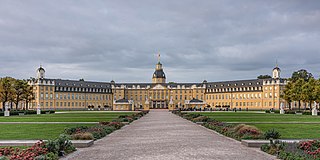
Karlsruhe is the third-largest city of the German state of Baden-Württemberg, after its capital Stuttgart and Mannheim, and the 22nd-largest city in the nation, with 308,436 inhabitants. It is also a former capital of Baden, a historic region named after Hohenbaden Castle in the city of Baden-Baden. Located on the right bank of the Rhine near the French border, between the Mannheim-Ludwigshafen conurbation to the north and Strasbourg to the south, Karlsruhe is Germany's legal center, being home to the Federal Constitutional Court, the Federal Court of Justice and the Public Prosecutor General.

Egyptian Revival is an architectural style that uses the motifs and imagery of ancient Egypt. It is attributed generally to the public awareness of ancient Egyptian monuments generated by Napoleon's conquest of Egypt and Admiral Nelson's defeat of the French Navy at the Battle of the Nile in 1798. Napoleon took a scientific expedition with him to Egypt. Publication of the expedition's work, the Description de l'Égypte, began in 1809 and was published as a series through 1826. The size and monumentality of the façades discovered during his adventure cemented the hold of Egyptian aesthetics on the Parisian elite. However, works of art and architecture in the Egyptian style had been made or built occasionally on the European continent since the time of the Renaissance.
The year 1826 in architecture involved some significant architectural events and new buildings.

Synagogue architecture often follows styles in vogue at the place and time of construction. There is no set blueprint for synagogues and the architectural shapes and interior designs of synagogues vary greatly. According to tradition, the Shekhinah or divine presence can be found wherever there is a minyan, a quorum, of ten. A synagogue always contains an Torah ark where the Torah scrolls are kept, called the aron qodesh by Ashkenazi Jews and the hekhal by Sephardic Jews.
The year 1798 in architecture involved some significant events.

The Spanish and Portuguese Synagogue of Montreal, also known as Shearith Israel, is an Orthodox synagogue, located at 4894 Avenue Saint-Kevin in Snowdon, Montreal, Quebec, Canada. The synagogue is the oldest Jewish congregation in Canada. The congregation traces its history from 1760 and was formally established in 1768. It is affiliated with the Orthodox Union.

Congregation Mikveh Israel, is a Sephardic Orthodox Jewish synagogue located at 44 North Fourth Street in Philadelphia, Pennsylvania, in the United States. The congregation traces its history from 1740. Mikveh Israel is a Spanish and Portuguese congregation that follows the rite of the Amsterdam esnoga. It is the oldest synagogue in Philadelphia, and the longest running in the United States.

Heinrich Hübsch was a German architect. After studies in Heidelberg (1813–15) and at Friedrich Weinbrenner's school of architecture in Karlsruhe (1815–17) he traveled extensively in Greece and Italy (1817–24). In 1831 he was appointed Oberbaurat at Karlsruhe. He designed many churches and other public buildings, mainly in the Grand Duchy of Baden, and is also known for his writings.

The Great Synagogue is an Orthodox Jewish congregation and synagogue, located at Krystalgade 12, in Copenhagen, Denmark. The congregation was formed at some stage during the 17th century and their first synagogue completed in 1766. The current synagogue was completed in 1833 and is defined by its unique architecture around the Ark. During the first half of the 19th century, synagogues continued to be built in the classical tradition, but there began to be a revival of Greek and Roman architecture. The Great Synagogue in Copenhagen is one of a few synagogues of its period to use Egyptian elements in the columns, ceiling and cornice over the ark.

TheGreat Synagogue is an Orthodox Jewish congregation located in a large heritage-listed synagogue at 187a Elizabeth Street in the Sydney central business district in the City of Sydney in New South Wales, Australia.
Diana Muir, also known as Diana Muir Appelbaum, is an American historian from Newton, Massachusetts, best known for her 2000 book, Reflections in Bullough's Pond, a history of the impact of human activity on the New England ecosystem.

The Badisches Staatstheater Karlsruhe is a theatre and opera house in Karlsruhe, Germany. It has existed in its present form and place at Ettlinger Tor since 1975. Achim Thorwald became the Intendant in summer 2002 and held that post until the end of the 2010/11 season. Peter Spuhler succeeded him at the beginning of the 2011/12 season and continues to serve in that post.

Ramath Orah is an Modern Orthodox synagogue located on West 110th Street in the Upper West Side of Manhattan, in New York City, New York, United States. Located close to Columbia University the synagogue occupies a neo-Georgian building that was built in 1921 as the first stage of a large West Side Unitarian Church.

The Hobart Synagogue is a heritage-listed synagogue located in 59 Argyle Street, Hobart, Tasmania, Australia. The synagogue is the oldest synagogue building in Australia and is a rare example of the Egyptian Revival style of synagogue architecture. The Egyptian Revival building was constructed in 1845. The trapezoidal shape of the windows and the columns with lotus capitals are characteristic of the Egyptian Revival style. Currently the Hobart Synagogue has regular Orthodox and Progressive services.
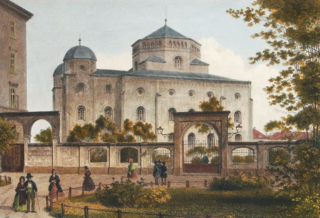
The Semper Synagogue, also known as the Dresden Synagogue or Old Synagogue, was a Jewish synagogue, located in Dresden, in the Saxony region of Germany. Designed by Gottfried Semper and built from 1838 to 1840 in the Romanesque Revival and Moorish Revival styles, the synagogue was destroyed by the Nazis on November 9, 1938, during Kristallnacht.
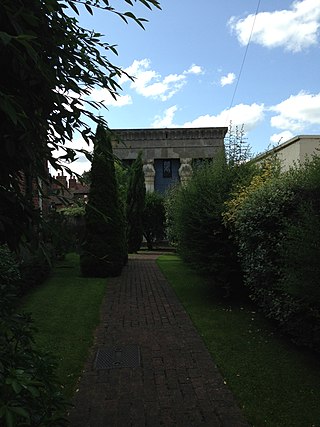
The Old Synagogue is a former Orthodox Jewish congregation and synagogue, located at 944 King Street in Canterbury, Kent, England, in the United Kingdom. Established in 1720, the congregation worshiped in the Ashkenazi rite until it was dissolved in c. 1911. Between 2008 and 2004, a non-denominational Jewish community occasionally worshiped in the former synagogue.
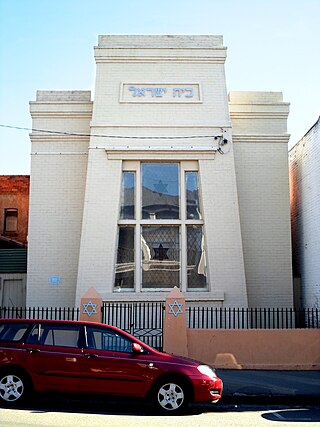
The Launceston Synagogue is a heritage-listed building located in St. John's Street, Launceston, Tasmania, Australia, that served as a synagogue from 1846 until 1871, and again during the c. 1930s until its closure in 1961 and reopened in 1984.
James Hume was one of the first architects in Sydney, Australia.
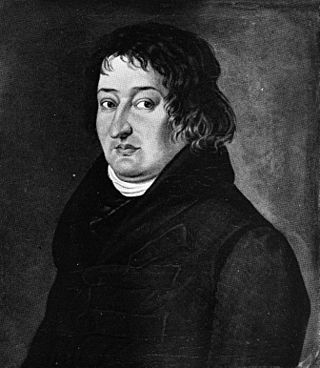
Friedrich Weinbrenner was a German architect and city planner admired for his mastery of classical style.

The Karlsruhe Pyramid is a pyramid made of red sandstone, located in the centre of the market square of Karlsruhe, Germany. It was erected in the years 1823–1825 over the vault of the city's founder, Margrave Charles III William (1679–1738). The pyramid is regarded as Karlsruhe's second emblem, the city's absolutist layout in the shape of a folding fan being the first.

















